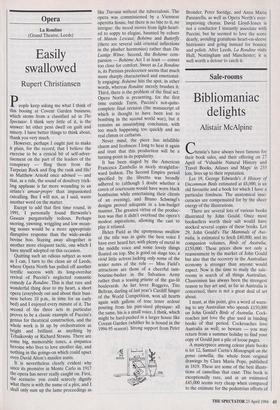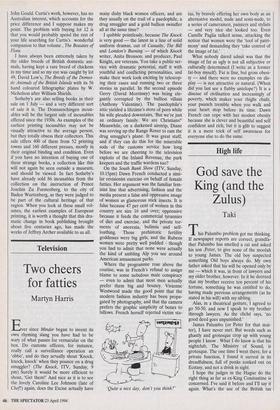Sale-rooms
Bibliomaniac delights
Alistair McAlpine
Christie's have always been famous for their book sales, and their offering on 27 April of 'Valuable Natural History and Travel Books, Atlases and Maps' in 233 lots, lives up to their reputation.
Lot 19, George Edwards's A History of Uncommon Birds estimated at £8,000, is an old favourite and a book for which I have a particular fondness. The anatomical inac- curacies are compensated for by the sheer energy of the illustrations.
There are several lots of various books illustrated by John Gould. Once most booksellers worth their salt would have stocked several copies of these books. Lot 29, John Gould's The Mammals of Aus- tralia, is estimated to fetch £40,000, and its companion volumes, Birds of Australia, £150,000. These prices show not only a reassessment by the market of John Gould but also that the recovery in the Australian economy is stronger than anyone would expect. Now is the time to study the sale- rooms in search of all things Australian. Chauvinism has always been the strongest reason to buy art and, as far as Australia is concerned, there is not a great deal of art about.
I must, at this point, give a word of warn- ing to any Australian who spends £150,000 on John Gould's Birds of Australia. Cock- roaches just love the glue used in binding books of that period. Cockroaches love Australia as well; so beware — you may return from a summer holiday to find your copy of Gould just a pile of loose pages.
A masterpiece among colour plate books is lot 12, Samuel Curtis's Monograph on the genus camellia, the whole from original drawings by Clara Maria Pope, published in 1819. These are some of the best illustr- tions of camellias that exist. This book is exceptionally rare, and at an estimated £45,000 seems very cheap when compared to the estimate for the pedestrian efforts of John Gould. Curtis's work, however, has no Australian interest, which accounts for the price difference and I suppose makes my point. The problem with buying lot 12 is that you would probably spend the rest of your life searching for Curtis's wonderful companion to that volume , The Beauties of Flora.
I have always been extremely taken by the older breeds of British domestic ani- mals, having kept a rare breed of chickens in my time and so my eye was caught by lot 49, David Low's, The Breeds of the Domes- tic Animals of the British Islands with its 56 hand coloured lithographic plates by W. Nicholson after William Shields.
Sotheby's are also selling books in their sale on 1 July — and a very different sort of sale it is. The Donaueschingen incun- ables will be the largest sale of incunables offered since the 1930s. As examples of the earliest printing incunables may not be visually attractive to the average person, but they totally obsess their collectors. This sale offers 400 of them from 52 printing towns and 160 different presses, mostly in their original binding and condition. Even if you have no intention of buying one of these strange books, a collection like this will not again be seen outside a museum, and should be viewed. In fact Sotheby's have already sold 86 incunables from the collection on the instruction of Prince Joachin Zu Furstenberg, to the city of Baden Wurtenberg, as they were judged to be part of the cultural heritage of that region. When you look at these small vol- umes, the earliest examples of European printing, it is worth a thought that this dra- matic change in book publishing brought about five centuries ago, has made the works of Jeffrey Archer available to us all.



























































 Previous page
Previous page